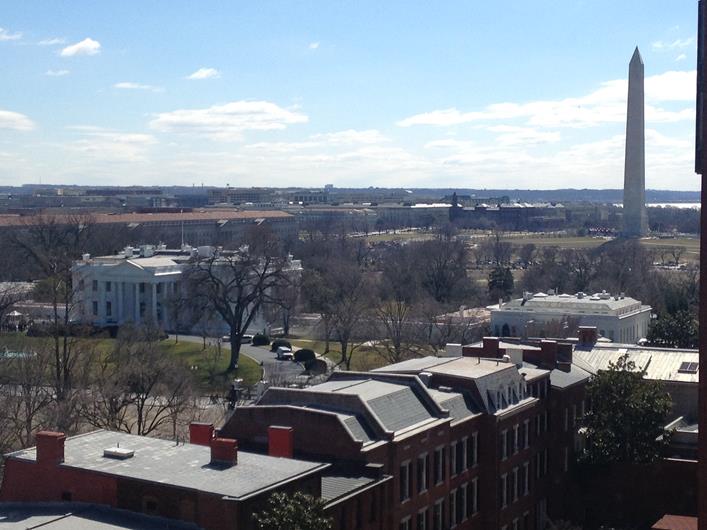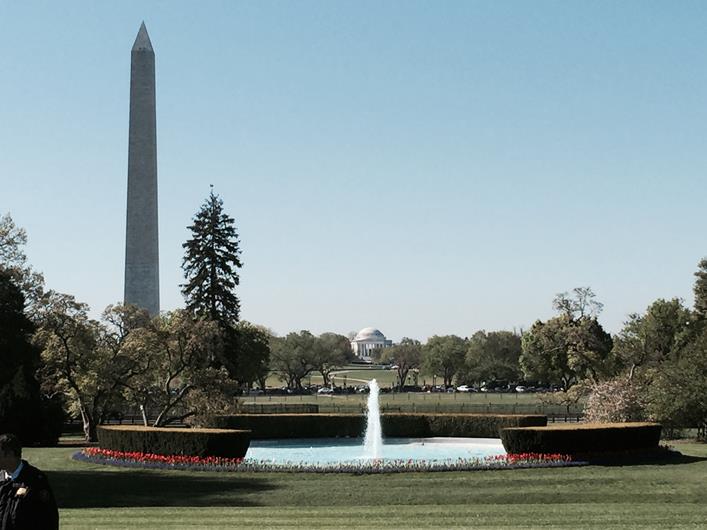The 2016 Election—What Happened, Why It Happened, and What's Next
2016年12月05日
米州住友商事会社 ワシントン事務所
James Winslow
• Introduction.

About a week before the election, I ran into an old friend at a local restaurant. Naturally, our conversation turned to the upcoming election, and he asked me who I thought would win. Like everyone who lives and works around Washington, I told him the House would stay Republican, the Senate would probably end up 50-50, and that Hillary Clinton would be the next President of the United States. "The country's changing demographics, the improving economy, and Donald Trump's campaign nearly guaranteed it," I said.
He told me I was completely wrong, and explained why. My friend owns a corporate advertising company that supplies t-shirts, coffee mugs, and other promotional products. His largest clients are the shops at Washington's three airports and Union Station. He said that for more than 30 years, whichever candidate sold the most t-shirts during the campaign had won the election without fail. He guaranteed a Trump victory.
• Election 2016: What Happened.
What did my friend's t-shirt sales reveal about an election that featured two extremely unpopular candidates—exit polls showed that while just 44% of voters had a favorable opinion of Hillary Clinton, even fewer, 38%, had a favorable opinion of Donald Trump? Although the sales were a measure of enthusiasm, they also spoke to the question on which this election ultimately turned, who could bring about change. And on the all-important question about change—voters favored Mr. Trump 83% to 14%.
Because of the nation's desire for change, Donald Trump is on track to carry 30 states and 306 electoral votes, while Mrs. Clinton will carry 20 states and the District of Columbia for a total of 232 electoral votes. At last count, Mrs. Clinton had 62.5 million votes and Mr. Trump had 61.2 million votes. While Mrs. Clinton's popular vote lead is expected to increase even further, this will be the fifth time in history that the winner of the Electoral College will have lost the popular vote. It will also be the 14th time that the winner did not receive at least 50% of the ballots cast. Nearly as surprising as the outcome of the presidential election, is the makeup of the incoming 115th Congress. While changing demographics and the number of Senate races contested seemed to favor Democrats prior to the election, Democrats are likely to pick up just six or seven seats in the House and Republicans will hold on to a slim majority in the Senate. In fact, when viewed across all 50 states, the momentum for change across President Obama's two terms is striking. Consider that the number of Democratic senators has fallen from 60 to 46 and the number of Democrats in Congress has fallen from 257 to 193 over the past eight years. Even more startling figures can be seen at the state level where the total number of Republican state seats held has risen from 3223 to 4151 since 2009.
• Election 2016: Why It Happened.
Among a host of issues, the 2016 election was supposed to be about turnout and a new coalition of progressive voters. However, although the pool of eligible voters rose 5.5% compared to four years ago, the number of ballots cast increased just 1.5%. More remarkable than even this, the number of votes cast for the two major party candidates fell in absolute terms compared to 2012, and third-party candidates grabbed their biggest share of votes since 1996. In the end, exit polls showed that this year's vote was a rejection of the Washington establishment, both Democrat and Republican, and a vote for change. It is important to point out that on Election Day, 62% of the country thought the U.S. was on the wrong track, and of the 23% who were "angry" with the federal government, 77% voted for Mr. Trump; of the 46% who were merely "dissatisfied" with government, they also voted for Trump over Clinton 49% to 45%. Despite what you may hear in the American media, this election did not turn on racism or misogyny. Of the nearly 700 counties President Obama won twice, almost one-third flipped to Donald Trump; what's more, Mr. Trump won 194 of the 207 counties that voted for President Obama in either 2008 or 2012; and of the 2200 counties that never supported President Obama, Mrs. Clinton won just six; she was clearly identified as the establishment candidate in an anti-establishment change election.
• Election 2016: What's Next?

So, what can we expect from an incoming Trump administration? This is the $64,000 question, and the answer is nobody really knows. While President-elect Trump has outlined a list of items he plans to address during his first 100 days in the White House, he is still assembling his cabinet, and has already appeared to back-track on campaign promises concerning elements of the Affordable Care Act [Obamacare], climate change, and prosecuting Hillary Clinton. On an issue of extreme importance to multi-national corporations, trade, in general, we can expect increased enforcement, the likely labeling of China as a currency manipulator, and a possible renegotiation of NAFTA. In terms of the Trans-Pacific Partnership (TPP), what we do know is that a vote will not occur during the lame duck session; however, members of the Senate Finance Committee are hopeful that they will be able to appeal to the businessman's side of the President-elect on trade, including making modifications to TPP.
• Conclusion.
Whether inside or outside the Washington beltway, most everyone is trying to better understand what a Trump presidency will mean for the public policies that impact their businesses. One of the best pieces of insight I've seen, and what t-shirt buyers seemed to grasp intuitively, comes from Mr. Trump's own book The Art of the Deal. In it he refers to "truthful hyperbole," which he describes as an innocent form of exaggeration that is effective as a form of promotion. What this essentially means is that while critics take Mr. Trump literally, but not seriously, the president-elect's supporters take him seriously, but not literally. So, when Donald Trump says he wants to build a wall, critics imagine a great brick wall spanning the entire length of the U.S. southern border. But supporters interpret these same words somewhat differently. What they hear him saying is that he is going to take a hardline approach to border security and illegal immigration.
記事のご利用について:当記事は、住友商事グローバルリサーチ株式会社(以下、「当社」)が信頼できると判断した情報に基づいて作成しており、作成にあたっては細心の注意を払っておりますが、当社及び住友商事グループは、その情報の正確性、完全性、信頼性、安全性等において、いかなる保証もいたしません。当記事は、情報提供を目的として作成されたものであり、投資その他何らかの行動を勧誘するものではありません。また、当記事は筆者の見解に基づき作成されたものであり、当社及び住友商事グループの統一された見解ではありません。当記事の全部または一部を著作権法で認められる範囲を超えて無断で利用することはご遠慮ください。なお、当社は、予告なしに当記事の変更・削除等を行うことがあります。当サイト内の記事のご利用についての詳細は「サイトのご利用について」をご確認ください。
 レポート・コラム
レポート・コラム
 SCGRランキング
SCGRランキング
- 2024年4月14日(日)
『日経ヴェリタス』に、当社シニアエコノミスト 鈴木 将之のコメントが掲載されました。 - 2024年4月12日(金)
日経CNBC『World Watch』に当社シニアアナリスト 石井 順也が出演しました。 - 2024年4月9日(火)
ラジオNIKKEI第1『マーケット・トレンドDX』に、当社チーフエコノミスト 本間 隆行が出演しました。 - 2024年4月9日(火)
『日本経済新聞』に、当社チーフエコノミスト 本間 隆行のコメントが掲載されました。 - 2024年4月9日(火)
『日刊産業新聞』に、当社チーフエコノミスト 本間 隆行のコメントが掲載されました。

